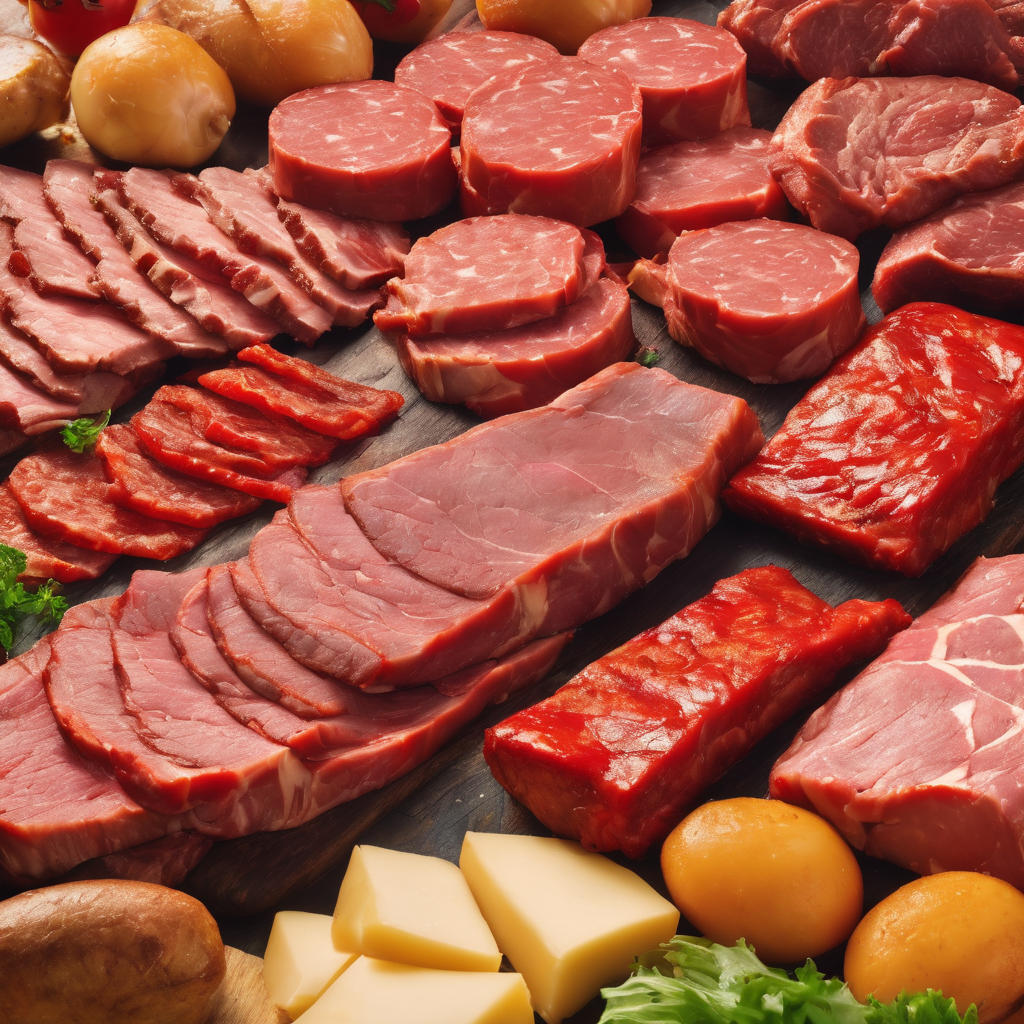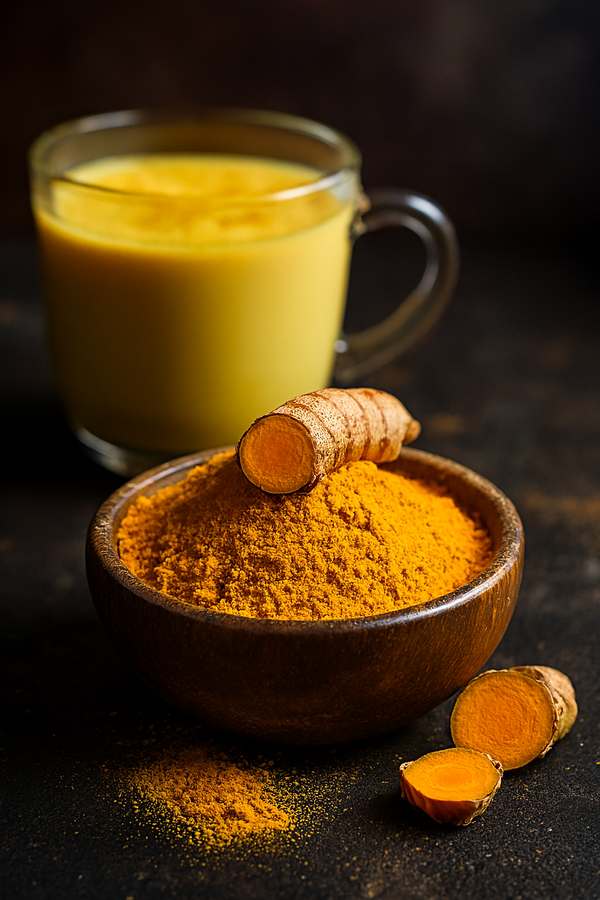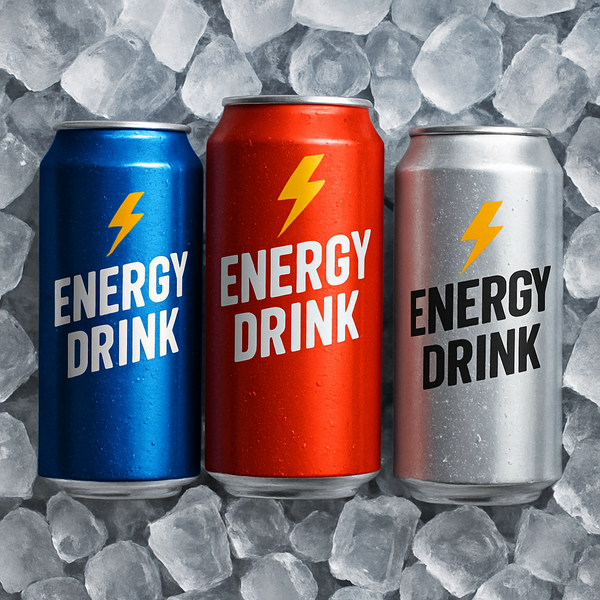Q&A: How Does Consuming Meat Affect Cancer Risk?
Meat consumption, particularly red and processed types, is linked to increased cancer risk. Adopting healthier cooking methods and moderating intake can mitigate these risks. Understanding and personalising dietary choices based on the latest research and individual health profiles is crucial.


Take-home message:
|
Aspect |
Take-Home Message |
|
Meat Types |
Red meat includes beef, pork, lamb, while processed
meat refers to products like bacon, sausages and deli meats. |
|
Cancer Risk |
Both red and processed meats are linked to an
increased risk of various cancers such as colorectal, stomach, pancreatic and
more. |
|
Cooking Methods |
Methods like boiling, steaming and baking at lower
temperatures can reduce the formation of harmful compounds like heterocyclic
amines and polycyclic aromatic hydrocarbons. |
|
Genetic Factors |
Individuals with certain genetic predispositions,
like the rapid variants of N-acetyltransferase 2 alleles, may have increased
cancer risk from meat ingestion. |
|
Preparation Techniques |
Marinating, cooking at lower temperatures and
pairing meat with antioxidants can mitigate some carcinogenic risks. |
|
Lab-Grown Meat |
Emerging as a modern alternative, lab-grown meat may
offer fewer contaminants but long-term health impacts are still under
investigation. |
|
Dietary Guidelines |
Generally, it is recommended to limit red meat
intake and minimise processed meat consumption for better health outcomes. |
|
Nitrate-Free Products |
"Nitrate-free" processed meats may still
carry similar health risks as they often contain natural sources of nitrates. |
|
Raw Meat Preparations |
Raw meat dishes from various cuisines need careful
preparation to mitigate health risks, with a focus on quality and hygiene. |
Introduction
Cancer is a group of diseases characterised by uncontrolled cell growth and spread, forming tumors that can be benign (non-cancerous) or malignant (cancerous). While benign tumors do not spread and are usually not life-threatening, malignant tumors can invade tissues. Cancer cells cannot perform the normal functions of the tissues they replace, disrupting the body's regular processes. Additionally, cancer cells can metastasise (spread to other parts of the body), making cancer particularly dangerous and challenging to treat. Cancer can develop in almost any body part and is classified by its origin, with over 100 types named after the organs or tissues where they form, such as lung cancer starting in the lungs and breast cancer in the breast. Additionally, cancers can be categorised by the type of cell they originate from, including carcinomas (epithelial cells), sarcomas (connective tissues), leukaemia’s (blood-forming tissues) and lymphomas (immune system cells). Cancer is caused by mutations in the DNA within cells, which can be inherited, triggered by environmental factors like tobacco smoke and radiation, or occur randomly during cell division. Cancer symptoms vary based on the type and location of the disease, with common signs including lumps, unexplained weight loss, fatigue and skin changes. Diagnosis involves imaging tests like X-rays and magnetic resonance imaging scans (MRIs), laboratory tests and biopsies. Treatment options depend on the cancer's type, location, stage and the patient's overall health, and include surgery, radiation therapy, chemotherapy, immunotherapy, targeted therapy and hormone therapy to eliminate cancer cells, control their spread or relieve symptoms.
Cancer remains one of the leading causes of morbidity and mortality worldwide, with millions of new cases diagnosed each year. According to the Global Cancer Statistics 2020, there were an estimated 19.3 million new cancer cases and nearly 10 million cancer deaths worldwide in 2020, with breast, lung, colorectal, prostate and stomach cancers being the most common (1). In South Africa, cancer incidence is also a significant health concern, with an estimated 107,467 new cases reported in 2020 (1).
Cancer is largely preventable through lifestyle and environmental modifications (2). Research indicates that up to 40% of cancers can be prevented by adopting healthy behaviours such as maintaining a balanced diet, engaging in regular physical activity, avoiding tobacco and limiting alcohol consumption (2). The World Cancer Research Fund (WCRF) also identifies several key lifestyle factors that can reduce cancer risk: maintaining a healthy weight, eating a diet rich in whole grains, vegetables, fruits and beans, limiting fast foods and other processed foods high in fat, starches or sugars, limiting consumption of red and processed meat and reducing sugar-sweetened drinks (2, 3). Additionally, the WCRF recommends breastfeeding for mothers to reduce breast cancer risk and following guidelines for cancer prevention after a cancer diagnosis. Early detection through screening programs and vaccinations against cancer-causing viruses like human papillomavirus (HPV) and hepatitis B can reduce the risk. By prioritising these preventive measures, individuals can decrease their chances of developing cancer and improve their overall health and well-being.
Here, I am reviewing the evidence for the link between meat consumption, particularly red and processed meat and cancer risk. I explore the relationship between meat consumption and cancer risk revealed by systematic reviews (review of research evidence on a specific topic) and meta-analysis (a statistical technique that combines results from multiple studies to provide a precise estimate of the effect size or association), the genetic link involving N-acetyltransferase 2 (NAT2) variants, preparation methods to reduce carcinogens, the potential of lab-grown meat and guidelines for healthy meat consumption.
The Relationship Between Meat Consumption and Cancer Risk
Red meat refers to the muscle meat of mammals, which is typically red in colour when raw. Red meats do not include chicken or fish but include beef, veal, lamb, mutton, goat and pork, with pork classified as red meat due to its myoglobin content, a protein in muscle tissue that binds oxygen and imparts the characteristic red colour to the meat. Processed meats are meats that have been preserved by smoking, curing, salting, or adding chemical preservatives or other processes to enhance flavour or preservation. Processed meats include products like bacon, sausages, hot dogs, deli meats (salami, ham and pastrami) and biltong. Additionally, lab-grown meat, also called cultured, in vitro, or artificial from animal cells, has emerged as a modern alternative, yet its long-term health impacts are still under study (4).
The consumption of meats has been scrutinised by the WCRF/American Institute of Cancer Research (2, 3) and researchers around the world. Red and processed meats have been associated with an increased risk of various types of cancer, including those of the oesophagus (muscular tube connecting the throat to the stomach), stomach, colorectal (colon and rectal) and pancreatic cancers (see Table below for a summary). Due to compelling evidence some of which are presented here, the International Agency for Research on Cancer (IARC) classifies red meat as Group 2A (probably carcinogenic to humans) and processed meat as Group 1 (carcinogenic to humans) (5).
Table: Summary of Research Studies on Meat Consumption and Cancer Risk
|
Study |
Meat Type |
Cancer Type |
Finding |
Studies Included |
|
Alexander et al. (6) |
Red and Processed Meat |
Breast |
No significant association with breast
cancer risk from red or processed meat intake. |
9 studies including data from eight
cohorts |
|
Chan et al. (7) |
Red and Processed Meat |
Colorectal |
Increased risk of colorectal cancer with
increased meat intake, risk plateaus after 140g/day. |
24 prospective studies (2 case-cohort, 3
nested case-control and 19 cohort studies) |
|
Choi et al. (8) |
Red Meat |
Oesophageal |
Increased red meat consumption
associated with higher oesophageal cancer risk. |
4 cohort, 23 case-control |
|
Farvid et al. (9) |
Red and Processed Meat |
Various |
High intake of red meat is associated with increased risk of
several cancers including breast, endometrial, colorectal, colon, rectal,
lung and hepatocellular carcinoma. Processed meat consumption is linked with
higher risk of breast, colorectal, colon, rectal and lung cancers. Total red
and processed meat consumption is associated with increased risk of
colorectal, colon, rectal, lung and renal cell cancers. |
148 published articles |
|
Guo et al. (10) |
Red and Processed Meat |
Breast |
Increased intake of red and processed meat is associated with an
increased risk of breast cancer; findings indicate a modest but significant
association for both meat types. |
14 prospective studies on red meat and 12 on processed meat |
|
Larsson and Wolk (11) |
Red and Processed Meat |
Pancreatic |
Processed meat increases pancreatic
cancer risk in both genders; red meat increases risk in men. |
11 prospective studies |
|
Larsson
et al. (12) |
Processed Meat |
Stomach |
Higher intake of processed meat
associated with elevated stomach cancer risk. |
6 prospective, 9 case-control |
|
Li et al. (13) |
Red and Processed Meat |
Bladder |
No significant association with bladder
cancer from red meat intake; however, a significant positive association was
observed between processed meat consumption and bladder cancer, especially in
populations from the American continent. |
14 studies on red meat and 11 studies on
processed meat |
|
Poorolajal, Mohammadi (14) |
Red and Processed Meat and Fish |
Oesophageal, Pancreatic, Liver, Colon,
Rectal, Colorectal |
High levels of red meat consumption increase the
risk of oesophageal, pancreatic, liver, colon, rectal and colorectal cancers.
High levels of processed meat consumption increase the risk of pancreatic,
colon, rectal and colorectal cancers. High levels of fish consumption reduce
the risk of colon, rectal and colorectal cancers. |
95 studies |
|
Zhao et al. (15) |
Red and Processed Meat |
Colorectal, Colon, Proximal Colon,
Distal Colon, Rectal |
Positive associations were found between
both red and processed meat consumption and overall colorectal cancer in both
case-control and cohort studies. No associations were found for distal colon
cancer with red meat and proximal colon cancer with processed meat. Varied
results for rectal cancer with positive associations in case-control studies
but not in cohort studies. |
60 studies |
Cancer risks associated with meat consumption are influenced by cooking methods that produce carcinogens like heterocyclic amines and polycyclic aromatic hydrocarbons, as well as inherent meat components such as haeme iron, which promotes the formation of damaging N-nitroso compounds and free radicals. Additionally, the intake of red meat introduces N-Glycolylneuraminic acid (Neu5Gc) into the body, potentially triggering xenosialitis—a chronic inflammatory response that, in combination with other carcinogenic compounds from meat, may exacerbate cancer risks through complex dietary, immune and genetic interactions (16, 17). These processes are complex and multifaceted, involving oxidative stress and possibly the gut microbiome (18). Additionally, animal products contain saturated fat and there is evidence suggesting a relationship between high intake of saturated fat, commonly found in meat, and an increased risk of cancer (19, 20). High consumption of saturated fat can contribute to inflammation and other biological processes that may promote cancer development. Understanding and moderating meat and the concomitant saturated fat consumption, coupled with maintaining a balanced diet, is essential to reduce these cancer risks. Public and personal health decisions should be informed by the cumulative scientific evidence highlighting these associations.
Exploring the Genetic Link: NAT2 Variants and Cancer Risk from Meat Consumption
The NAT2 enzyme plays a crucial role in the metabolism of carcinogenic compounds. Certain individuals have a higher risk of developing cancer from meat consumption due to genetic predispositions, notably those with the 'rapid' variants of NAT2 alleles. These variants are linked to an accelerated metabolism of carcinogenic compounds like heterocyclic amines. While Wang and colleagues (21) demonstrated that Japanese and African American individuals with the NAT2 rapid phenotype experience an increased risk of colorectal cancer with red meat intake, a pooled analysis has reported varying results on the impact of NAT2 enzyme activity on cancer risk (22). This discrepancy highlights the need for continued research to accurately understand and personalise dietary recommendations based on genetic susceptibility and individual responses to meat consumption.
Reducing Carcinogens in Meat Through Preparation Methods
The method of meat preparation impacts associated health risks (23, 24). Techniques such as poaching or boiling at lower temperatures, sous-vide for precise, low-temperature cooking, pressure cooking to avoid high heat, partial cooking in the microwave, trimming excess fat, frequent turning to avoid charring, using acidic marinades, avoiding direct flame exposure, removing charred portions, pairing meat with antioxidant-rich vegetable, and utilising air frying at temperatures at or below 180˚C are healthier alternatives to traditional methods like stewing, oven-baking, griddle-grilling, barbecuing, and braaiing. These methods help reduce the formation of harmful compounds and promote a healthier diet, thereby lowering the risk of colorectal cancer. Marinating meat in herbs or antioxidant-rich oils before cooking or grilling can inhibit the formation of heterocyclic amines (25). Additionally, allowing adequate oxygen flow and maintaining lower cooking temperatures can diminish the production of polycyclic aromatic hydrocarbons (26). Furthermore, incorporating antioxidants like vitamin C, found in lemon juice and other sources, can mitigate the formation of nitrosamines, especially in nitrate-rich pink meats such as ham, pork and bacon (27, 28).
Table: Carcinogenic Compounds in Meats and Strategies for Risk Reduction
|
Carcinogen |
Source/Formation |
Associated Risks |
Mitigating Factors |
|
Heterocyclic Amines (HCAs) |
Formed when amino acids, sugars and
creatine react at high temperatures, prevalent in well-done and charred
meats. |
Linked to increased risk of various
cancers, including colorectal and stomach cancer. |
Marinating meats in herbs (rosemary,
thyme, garlic, onions, oregano, sage) or antioxidants (using vitamin E
containing oils, lemon or orange juice, crushed berries, grapes, or
a splash of wine) cooking at lower temperatures to reduce HCA formation. For
effective marination, extend the duration to boost herbs and antioxidants'
impact, use a diverse mix for optimal protection and ensure consistent
coating and turning for even distribution. |
|
Polycyclic Aromatic Hydrocarbons (PAHs) |
Originate from incomplete burning of
organic material, forming during grilling when fat drips onto the fire. |
Associated with lung, skin and urinary
cancers. |
Minimising direct exposure of meat to
open flames, avoiding charring to reduce PAH formation. |
|
Nitrosamines |
Found in processed meats preserved with
nitrites and nitrates, forming especially at high temperatures. |
Linked to various cancers, including
gastric and oesophageal cancers. |
Choosing meats with no added nitrates or
nitrites; avoiding bacon, macon, hot dogs, deli meats, sausages, cured hams,
corned beef, jerky, biltong, droë wors (a type of dried sausage from South
Africa), and canned meats; cooking at lower temperatures to reduce
nitrosamine formation. |
Footnote: There are products of both bacon and macon (a mutton alternative to bacon for non-pork eaters) marketed as "nitrate-free" or "uncured." These products typically use natural sources of nitrates, such as celery juice powder, instead of synthetic sodium nitrate. While marketed as a healthier alternative, the nitrate content might still be present from these natural sources and the overall health impact can be similar.
The doneness level of red meat influences cancer risk due to the formation of heterocyclic amines and polycyclic aromatic hydrocarbons. Medium, medium-rare, or rare meat involves lower temperatures and shorter cooking times, reducing the formation of these compounds but posing a risk of bacterial infections. Well-done meat, cooked at higher temperatures and for longer durations, increases the formation of heterocyclic amines and polycyclic aromatic hydrocarbons, which are linked to a higher risk of cancers (23). Michelin-level chefs often prefer cooking meat to medium-rare or medium to preserve its flavour, juiciness, texture, and visual appeal, which also provides health benefits over well-done meat.
Preparation of raw meat in various cuisines involves several techniques aimed at enhancing flavour and safety. Mincing and seasoning are used in dishes like steak tartare, while thinly slicing is typical for carpaccio. Kibbeh Nayyeh mixes raw meat with grains and spices and Larb is a spiced raw meat salad. These methods often involve acids, herbs and minimal heat to ensure palatability and safety. In South Africa, sushi is sometimes made with red meat like beef instead of traditional seafood, creating unique fusion dish to cater for local tastes and preferences. Adopting these preparation methods, especially when incorporating herbs and antioxidants, can help mitigate the formation of harmful compounds, potentially reducing cancer risk associated with meat consumption. Maintaining high standards of meat quality and hygiene is crucial in preparing and consuming these raw meat dishes. There are currently no data to address the question of eating raw meat in relation to cancer risk (WHO, 2015; https://www.who.int/news-room/questions-and-answers/item/cancer-carcinogenicity-of-the-consumption-of-red-meat-and-processed-meat). However, the separate question of risk of infection from consumption of raw meat needs to be kept in mind.
Table: Raw Meat Dishes from Around the World
|
Dish |
Pronunciation |
Description |
Region of
Origin |
|
Carpaccio |
\kar-PAH-chee-oh\
Sounds like kaa pa chee ow |
Thinly sliced
raw beef, often served with olive oil, lemon juice, and capers. |
Italy |
|
Steak Tartare |
\STAYK
tar-TAR\ Sounds like stayk taa taa |
Finely chopped
raw beef mixed with seasonings, often served with a raw egg yolk on top. |
France |
|
Kibbeh Nayyeh |
\KIB-beh
NAH-yeh\ |
A Middle
Eastern dish made from raw ground lamb or beef mixed with bulgur and spices. |
Lebanon/Syria |
|
Yukhoe |
\yook-HWAY\ |
A Korean-style
steak tartare dish of seasoned raw beef, often served with pear and an egg
yolk. |
Korea |
|
Gored Gored |
\GOR-ed
GOR-ed\ |
An Ethiopian
dish consisting of cubes of raw beef mixed with spices and clarified butter. |
Ethiopia |
|
Larb |
\LAHRB\ |
A Southeast
Asian dish made from minced raw beef mixed with herbs, lime juice, and fish
sauce. |
Laos/Thailand |
|
Sushi with Red
Meat |
\SOO-shee\ |
Fusion sushi
made with red meat like beef, combined with traditional sushi elements like
rice, seaweed, and vegetables. |
South Africa |
In addition to these, other raw meat preparations include jerky, biltong, or droë wors, which involve curing and drying (29). Biltong and similar dried meats' potential carcinogenicity stems from nitrates and nitrites used in curing, exposure to polycyclic aromatic hydrocarbons during smoking and high salt content (30). Salt itself is linked to cancer, particularly stomach cancer (31) and using salt in curing and preserving meat can add to the meat's carcinogenic potential. High salt intake can damage the stomach lining, leading to inflammation and increased susceptibility to carcinogens. When used in meat preservation, salt can contribute to the formation of harmful compounds like N-nitroso, which are known to be carcinogenic. While typically safe in moderation, these factors can increase cancer risk, particularly with high consumption or in diets rich in processed meats. Future research should continue to explore the impact of preparation methods on the carcinogenic potential of meats.
Lab-Grown Meat: A New Frontier in Reducing Cancer Risks and Its Future Implications
Lab-grown meat presents a unique opportunity to potentially reduce cancer risks associated with traditional meat consumption, such as lower contaminants and reduced need for harmful preservatives and does not contain any cancer-causing (oncogenic) compounds that have not been approved (32). However, like conventional meats, lab-grown varieties might still produce heterocyclic amines and polycyclic aromatic hydrocarbons when cooked at high temperatures. While lab-grown meat can be engineered for healthier fat content and fewer additives, the long-term effects and cancer risk profile are not yet understood, necessitating comprehensive studies and effective regulation to ensure safety and health benefits.
Guidelines for Healthy Meat Consumption: Quantity and Preparation
Meat is highly nutritious and can contribute to a balanced diet. It provides high-quality protein essential for muscle growth, tissue repair and enzyme production. Meat also supplies vital micronutrients such as iron, zinc and B vitamins (especially B12), crucial for energy, immune function, and neurological health. Haeme iron in meat, particularly red meat, is more readily absorbed than non-haeme iron from plants, preventing iron deficiency anaemia. Zinc supports immune response, DNA synthesis and cell division. Vitamin B12, found almost exclusively in animal products, is essential for nerve health and red blood cell production. While meat is valuable for a healthy diet, it is important to consume it prudently.
The dietary guidelines for meat consumption, whether processed, unprocessed or lab-grown, can vary based on the latest research, cultural dietary norms and individual health profiles. However, general guidelines have been provided by various health organisations. The WCRF and the American Institute for Cancer Research have a general recommendation regarding animal foods: "Limit intake of red meat and avoid processed meat" (2, 3). The South African Food-Based Dietary Guidelines (SAFBDG) that pertains to red meat is: “Fish, chicken, lean meat or eggs can be eaten daily” (33). This promotes lean red meat in moderation as part of a balanced diet with varied protein sources.
Table: Dietary Guidelines and Healthy Meat Preparation Tips
|
Type of Meat |
General Guidelines - Quantity |
General Guidelines - Preparation |
Genetic Predisposition - Quantity |
Genetic Predisposition - Considerations |
|
Unprocessed Red Meat (Beef, Veal, Pork, Lamb) |
Limit to 2–3 servings per week (90–120 g or 3–4 oz
each)(34) |
Prefer
baking, broiling, steaming, boiling, or air frying (below 180˚C) to reduce
charring |
Consume less than general recommendations |
Cook at lower temperatures to reduce harmful
compound formation |
|
Processed Meat (Sausages, Ham, Bacon, Deli Meats) |
Minimise consumption frequency, aim for rare or
small quantities |
Choose products with lower salt and nitrate content |
Avoid or consume sparingly |
Increased risk warrants higher caution or complete
avoidance |
Footnote: These guidelines are general and may not apply to every individual. It's essential to consult with healthcare providers or a genetic counsellor for personalised advice, especially if there's a known genetic predisposition to cancer. Emphasise variety and balance by incorporating plenty of fruits, vegetables, whole grains and other plant-based protein sources into your diet alongside meat, regardless of genetic predisposition. Ensure early detection and prevention strategies through regular medical screening and consultations, especially important for those with a known genetic predisposition. Adopting other healthy lifestyle choices including maintaining a healthy weight, exercising regularly, and avoiding smoking and excessive alcohol consumption.
Reducing unhealthy meat intake while still including meat in your diet involves making informed choices about the type, quantity and preparation methods of meat. Understanding portion sizes is crucial; a portion of 90–120 grams (3–4 ounces) of meat is roughly equivalent to the size of a standard deck of cards, the palm of an adult's hand, or a typical smartphone. To reduce portion sizes one can use substitutions, however, certain substitutions are not necessarily healthier. For instance substituting minced beef with cricket powder, while safe, is not inherently a healthier option compared to beef (35). Replacing red or processed meat with legumes do not reduce the risk of liver cancer (36). Replacing red or processed meat with whole grains, vegetables, or fruits, even in small amounts, could reduce the risk of colorectal cancer in populations that consume a lot of meat (37). Another option is substituting red or processed meat with chicken or fish (14, 38) or with plant-based meat alternatives such as mushroom-based protein products (39).
Table: Practical tips to reduce unhealthy meat intake
|
Strategy |
Description |
|
Choose Lean Cuts |
Opt for leaner cuts like chicken breast, turkey or
lean beef and pork. Trim fat and remove poultry skin before cooking. |
|
Limit Processed Meats |
Minimise consumption of processed meats (e.g.,
bacon, sausages). Look for lower sodium and nitrate-free options. |
|
Reduce Portion Sizes |
Stick to 90–120 grams (3–4 ounces) per serving of
meat (34), complementing with vegetables, fruits, whole
grains or legumes. |
|
Increase Plant-based Meals |
Partially substitute red or processed meat with
grains, vegetables and fruits (40). Introduce meatless days or meals including high
protein containing beans, lentils, tofu, nuts and seeds to reduce overall
meat intake. |
|
Practice Mindful Eating |
Be aware of meat consumption habits and motivations,
adjusting as needed for health and preference. |
|
Enhance Flavours Without Meat |
Use herbs, spices and healthy sauces to make
vegetarian dishes appealing, reducing reliance on meat for flavour. |
|
Try Meat Substitutes |
Explore plant-based options like veggie burgers and
plant-based sausages for similar textures and flavours. |
|
Combine Meat with Meat Substitutes |
Mix meat mince with soya mince, adjusting
proportions and seasonings for healthier, balanced meals. |
|
Substitute processed and red meats with fish or
chicken |
Consume fish or chicken instead of processed and red
meats, which are significantly associated with a decreased risk of colon,
rectal and colorectal cancers (14, 38). |
|
Prepare Meat Healthily |
Employ cooking methods like grilling, baking,
steaming or stir-frying. Marinate meat to reduce harmful compounds. |
|
Balance with Healthy Sides |
Serve meat with vegetables, whole grains, or salads
for a balanced and healthy meal. Enjoy a variety of fruits, vegetables
including microgreens, grains, legumes, and nuts as sides, as individuals
with the highest natural antioxidant intake showed no association between red
meat and cancer risk (41). |
|
Stay Informed |
Keep abreast of the latest nutritional information
and recommendations regarding meat consumption. |
Conclusion
The correlation between meat consumption and increased cancer risk is evident, particularly with processed and red meats linked to various malignancies. Current research points to haeme iron and carcinogens formed during meat processing and cooking as key factors. However, understanding these risks empowers individuals to make informed dietary decisions. By moderating meat intake, choosing healthier cuts and preparation methods, and balancing diets with plant-based foods, individuals can mitigate these risks. Incorporating regular screenings and staying informed about the latest dietary guidelines are also crucial steps in maintaining health and reducing cancer risk. Beyond meat intake, adopting a holistic approach to cancer prevention involves addressing other modifiable risk factors such as avoiding tobacco, limiting alcohol consumption, maintaining a healthy weight, engaging in regular physical activity and reducing exposure to environmental toxins. Ultimately, while meat can be part of a balanced diet, awareness and thoughtful consumption, alongside a comprehensive approach to lifestyle choices, are essential for reducing cancer risk and promoting overall health.
Reflections:
What types of meat do you consume over a week? How much do you eat in one sitting? Note down red and processed meat quantities, cooking methods and frequency. How does your consumption align with the recommended guidelines for red and processed meat intake? How do you feel about the health implications associated with your consumption patterns? Do you want to reduce the amount of red or processed meat, try healthier cooking methods, or introduce more meat-free days? Consider experimenting with the doneness of your meat. Would you be willing to try cooking your meat to medium or medium-rare instead of well-done? Reflect on how this change might affect the flavour and juiciness of your meals, as well as the potential health benefits. Based on your reflections and what you have learned, set specific, measurable, achievable, relevant, and time-bound (SMART) goals for your meat intake. If you have specific health concerns or a family history of cancer, schedule a time to discuss with a healthcare provider or a dietitian how you can tailor your diet to reduce risks.
Love what you’re reading? Share the knowledge! 📨 Forward this link to a friend who might also enjoy it.
References
1. Sung H, Ferlay J, Siegel RL, Laversanne M, Soerjomataram I, Jemal A, et al. Global Cancer Statistics 2020: GLOBOCAN Estimates of Incidence and Mortality Worldwide for 36 Cancers in 185 Countries. CA: A Cancer Journal for Clinicians. 2021;71(3):209-49.
2. Research WCRFAIfC. Policy and action for cancer prevention. Food, nutrition, and physical activity: a global perspective. AICR Washington, DC; 2009.
3. Clinton SK, Giovannucci EL, Hursting SD. The world cancer research fund/American institute for cancer research third expert report on diet, nutrition, physical activity, and cancer: impact and future directions. The Journal of nutrition. 2020;150(4):663-71.
4. Chriki S, Hocquette J-F. The myth of cultured meat: a review. Frontiers in nutrition. 2020;7:7.
5. Working IM. Carcinogenicity of consumption of red and processed meat. 2015.
6. Alexander DD, Cushing CA, Mink PJ, Morimoto LM. A review and meta-analysis of red and processed meat consumption and breast cancer. Nutrition Research Reviews. 2010;23(2):349-65.
7. Chan DS, Lau R, Aune D, Vieira R, Greenwood DC, Kampman E, et al. Red and processed meat and colorectal cancer incidence: meta-analysis of prospective studies. PloS one. 2011;6(6):e20456.
8. Choi Y, Song S, Song Y, Lee JE. Consumption of red and processed meat and esophageal cancer risk: meta-analysis. World J Gastroenterol. 2013;19(7):1020-9.
9. Farvid MS, Sidahmed E, Spence ND, Mante Angua K, Rosner BA, Barnett JB. Consumption of red meat and processed meat and cancer incidence: a systematic review and meta-analysis of prospective studies. European Journal of Epidemiology. 2021;36(9):937-51.
10. Guo J, Wei W, Zhan L. Red and processed meat intake and risk of breast cancer: a meta-analysis of prospective studies. Breast Cancer Research and Treatment. 2015;151(1):191-8.
11. Larsson SC, Wolk A. Red and processed meat consumption and risk of pancreatic cancer: meta-analysis of prospective studies. British Journal of Cancer. 2012;106(3):603-7.
12. Larsson SC, Orsini N, Wolk A. Processed meat consumption and stomach cancer risk: a meta-analysis. Journal of the National Cancer Institute. 2006;98(15):1078-87.
13. Li F, An S, Hou L, Chen P, Lei C, Tan W. Red and processed meat intake and risk of bladder cancer: a meta-analysis. International journal of clinical and experimental medicine. 2014;7(8):2100.
14. Poorolajal J, Mohammadi Y, Fattahi-Darghlou M, Almasi-Moghadam F. The association between major gastrointestinal cancers and red and processed meat and fish consumption: A systematic review and meta-analysis of the observational studies. PloS one. 2024;19(6):e0305994.
15. Zhao Z, Feng Q, Yin Z, Shuang J, Bai B, Yu P, et al. Red and processed meat consumption and colorectal cancer risk: a systematic review and meta-analysis. Oncotarget. 2017;8(47):83306.
16. Cascella M, Bimonte S, Barbieri A, Del Vecchio V, Caliendo D, Schiavone V, et al. Dissecting the mechanisms and molecules underlying the potential carcinogenicity of red and processed meat in colorectal cancer (CRC): an overview on the current state of knowledge. Infectious Agents and Cancer. 2018;13(1):3.
17. Liang M, Wu J, Li H, Zhu Q. N‐glycolylneuraminic acid in red meat and processed meat is a health concern: A review on the formation, health risk, and reduction. Comprehensive Reviews in Food Science and Food Safety. 2024;23(2):e13314.
18. Abu‐Ghazaleh N, Chua WJ, Gopalan V. Intestinal microbiota and its association with colon cancer and red/processed meat consumption. Journal of Gastroenterology and Hepatology. 2021;36(1):75-88.
19. Kim Y, Je Y, Giovannucci EL. Association between dietary fat intake and mortality from all-causes, cardiovascular disease, and cancer: A systematic review and meta-analysis of prospective cohort studies. Clinical Nutrition. 2021;40(3):1060-70.
20. Mei J, Qian M, Hou Y, Liang M, Chen Y, Wang C, et al. Association of saturated fatty acids with cancer risk: a systematic review and meta-analysis. Lipids in Health and Disease. 2024;23(1):32.
21. Wang H, Iwasaki M, Haiman CA, Kono S, Wilkens LR, Keku TO, et al. Interaction between red meat intake and NAT2 genotype in increasing the risk of colorectal cancer in Japanese and African Americans. PloS one. 2015;10(12):e0144955.
22. Ananthakrishnan AN, Du M, Berndt SI, Brenner H, Caan BJ, Casey G, et al. Red Meat Intake, NAT2, and Risk of Colorectal Cancer: A Pooled Analysis of 11 Studies. Cancer Epidemiology, Biomarkers & Prevention. 2015;24(1):198-205.
23. de Batlle J, Gracia-Lavedan E, Romaguera D, Mendez M, Castaño-Vinyals G, Martín V, et al. Meat intake, cooking methods and doneness and risk of colorectal tumours in the Spanish multicase-control study (MCC-Spain). European Journal of Nutrition. 2018;57(2):643-53.
24. Budhathoki S, Iwasaki M, Yamaji T, Hamada GS, Miyajima NT, Zampieri JC, et al. Doneness preferences, meat and meat-derived heterocyclic amines intake, and N-acetyltransferase 2 polymorphisms: association with colorectal adenoma in Japanese Brazilians. European Journal of Cancer Prevention. 2020;29(1).
25. Smith JS, Ameri F, Gadgil P. Effect of marinades on the formation of heterocyclic amines in grilled beef steaks. J Food Sci. 2008;73(6):T100-5.
26. Sampaio GR, Guizellini GM, da Silva SA, de Almeida AP, Pinaffi-Langley ACC, Rogero MM, et al. Polycyclic aromatic hydrocarbons in foods: biological effects, legislation, occurrence, analytical methods, and strategies to reduce their formation. International Journal of Molecular Sciences. 2021;22(11):6010.
27. Herrmann SS, Granby K, Duedahl-Olesen L. Formation and mitigation of N-nitrosamines in nitrite preserved cooked sausages. Food Chemistry. 2015;174:516-26.
28. De Mey E, De Maere H, Paelinck H, Fraeye I. Volatile N-nitrosamines in meat products: Potential precursors, influence of processing, and mitigation strategies. Critical reviews in food science and nutrition. 2017;57(13):2909-23.
29. Aykın Dinçer E. Dried meat products obtained by different methods from past to present. Food Reviews International. 2023;39(5):2457-76.
30. Walubo A, Coetsee C, Badenhorst A. Effect of the South African traditional meat, biltong, on cancer-associated enzymes CYP2E1 and CYP1A2. South African Medical Journal. 2004;94(11):903-5.
31. Morais S, Costa A, Albuquerque G, Araújo N, Pelucchi C, Rabkin CS, et al. Salt intake and gastric cancer: a pooled analysis within the Stomach cancer Pooling (StoP) Project. Cancer Causes & Control. 2022;33(5):779-91.
32. Hanson J, Ranney J. Is lab-grown meat healthy and safe to consume? Center for Food Safety. 2020.
33. Schonfeldt HC, Hall N. “Fish, chicken, lean meat and eggs can be eaten daily”: a food-based dietary guideline for South Africa. South African Journal of clinical nutrition. 2013;26:S66-S76.
34. Pouzou JG, Zagmutt FJ. Guidelines to restrict consumption of red meat to under 350g/week based on colorectal cancer risk are not consistent with health evidence. Nutrition. 2024:112395.
35. Ververis E, Niforou A, Poulsen M, Pires SM, Federighi M, Samoli E, et al. Substituting red meat with insects in burgers: Estimating the public health impact using risk-benefit assessment. Food and Chemical Toxicology. 2024;189:114764.
36. Bock N, Langmann F, Johnston LW, Ibsen DB, Dahm CC. The Association between the Substitution of Red Meat with Legumes and the Risk of Primary Liver Cancer in the UK Biobank: A Cohort Study. Nutrients. 2024;16(15):2383.
37. Tammi R, Kaartinen NE, Harald K, Maukonen M, Tapanainen H, Smith-Warner SA, et al. Partial substitution of red meat or processed meat with plant-based foods and the risk of colorectal cancer. European Journal of Epidemiology. 2024:1-10.
38. English DR, MacInnis RJ, Hodge AM, Hopper JL, Haydon AM, Giles GG. Red Meat, Chicken, and Fish Consumption and Risk of Colorectal Cancer. Cancer Epidemiology, Biomarkers & Prevention. 2004;13(9):1509-14.
39. De Cianni R, Mancuso T, Rizzo G, Migliore G. Health or environment? Understanding which informative message is more effective in replacing red meat with mushroom-based alternatives. Appetite. 2024;199:107405.
40. Tammi R, Kaartinen NE, Harald K, Maukonen M, Tapanainen H, Smith-Warner SA, et al. Partial substitution of red meat or processed meat with plant-based foods and the risk of colorectal cancer. European Journal of Epidemiology. 2024.
41. Yang J, Na X, Li Z, Zhao A. Modification Role of Dietary Antioxidants in the Association of High Red Meat Intake and Lung Cancer Risk: Evidence from a Cancer Screening Trial. Antioxidants. 2024;13(7):799.
In the process of creating this work, the author employed ChatGPT 4 to streamline the text and to perform language editing.




